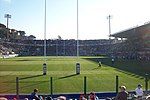Ponte Milvio
110s BC establishments2nd-century BC establishments in Italy2nd-century BC establishments in the Roman RepublicBridges completed in the 2nd century BCBridges in Rome ... and 7 more
Deck arch bridgesRoman bridges in ItalyRome Q. II ParioliRome Q. I FlaminioRome Q. XVIII Tor di QuintoRome Q. XV Della VittoriaStone bridges in Italy

The Milvian (or Mulvian) Bridge (Italian: Ponte Milvio or Ponte Molle; Latin: Pons Milvius or Pons Mulvius) is a bridge over the Tiber in northern Rome, Italy. It was an economically and strategically important bridge in the era of the Roman Empire and was the site of the famous Battle of the Milvian Bridge in 312, which led to the imperial rule of Constantine.
Excerpt from the Wikipedia article Ponte Milvio (License: CC BY-SA 3.0, Authors, Images).Ponte Milvio
Milvian Bridge, Rome Tor di Quinto
Geographical coordinates (GPS) Address External links Nearby Places Show on map
Geographical coordinates (GPS)
| Latitude | Longitude |
|---|---|
| N 41.935555555556 ° | E 12.466944444444 ° |
Address
Ponte Milvio
Milvian Bridge
00194 Rome, Tor di Quinto
Lazio, Italy
Open on Google Maps










